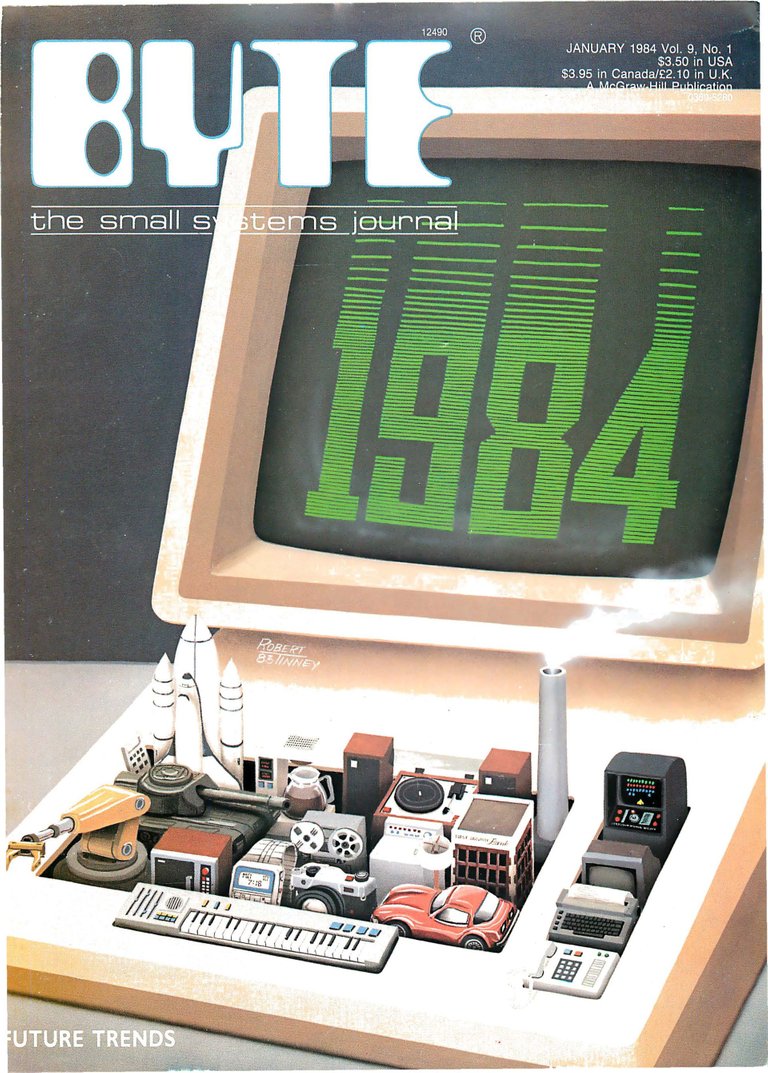BYTE: The Small Systems Journal (January 1984)
(Edited)

BYTE was a computer magazine published from 1975 until 1998, appearing not long after the first commercial computer kits started being advertised. It covered a vast array of computers over the years and included technical content as well as hardware and software reviews. The January 1984 issue was a massive 560+ pages and included:
Columns
- Build the Circuit Cellar Term-Mite ST Smart Terminal, Part 1: Hardware - Thanks to advancing technology, you can construct an intelligent video terminal with just 21 integrated circuits.
- BYTE West Coast: Beyond the Word Processor - Tomorrow's text editors may facilitate text composition from the earliest conceptual stages to the analysis of finished documents.
Themes
- 1984 and Beyond - The year calls up inevitable associations with George Orwell's novel of a futuristic, technologically oppressed society and raises questions concerning the present and future significance of technology to our own culture.
- Reason and the Software Bus - The Reason research project, exploring artificial intelligence, has developed a software bus that may have a significant effect on future software. As a hardware bus uses ICs, so the software bus manipulates various program components to provide integration, networking, and multitasking.
- A General-Purpose Robot-Control Language - By bridging the communication gap between people and robots, a plain-language system called Savvy increases the usefulness of these mechanical assistants.
- 1984, the Year of the 32-bit Microprocessor - As manufacturers rush to introduce their 32-bit designs, it's time to take a look at what these microprocessors are and what they're good for.
- Memory Cards: A New Concept in Personal Computing - Picture a microcomputer without a keyboard, without a power supply, and small enough to fit in your wallet. That's just one possible application of memory-card technology.
- Computer-aided Design - CAD capabilities on desktop systems can simplify a variety of tasks, from flowcharting to product design, but the choices in hardware and software can be baffling.
Reviews
- Reviewer's Notebook - This month's notes touch on Seequa Computer Corporation's Chameleon Plus and new trends in the printer market.
- The Zenith Z-100 - Supporting both 8-bit and 16-bit software, the Z-100 also offers impressive color graphics.
- Pinball Construction Set - Tired o fthe same old pinball games? Try creating your own with this software-design package.
- The TRS-80 Model 16B with Xenix - Once of the most significant features of Radio Shack's new computer is its Unix-derived operating system.
- Naturallink to Down Jones News/Retrieval - A new software package from Texas Instruments simplifies access to a financial database.
Features
- Bubbles on the S-100 Bus, Part 1: The Hardware - Using Intel's BPK 72 Bubble-Memory Prototype Kit, you can put together a 128K-byte bubble-memory board for an S-100 bus system.
- Mockingbird: A Composer's Amanuensis - The chief purpose of this music notation editor from Xerox is to help composers capture their ideas by speeding up the notation process.
- The VU68K Single-Board Computer - You can construct a 68000-based system for under $200.
Nucleus
- Editorial: Revisiting the Luddites
- MICROBYTES
- Letters
- BYTE's User to User
- Ask BYTE
- Software Received
- Event Queue
- Books Received
Read more: https://www.megalextoria.com/wordpress/index.php/2021/11/08/byte-january-1984/
0
0
0.000
https://twitter.com/Darth_Azrael/status/1458100730380836882
The rewards earned on this comment will go directly to the person sharing the post on Twitter as long as they are registered with @poshtoken. Sign up at https://hiveposh.com.
Source of plagiarism
Plagiarism is the copying & pasting of others' work without giving credit to the original author or artist. Plagiarized posts are considered fraud and violate the intellectual property rights of the original creator.
Guide: Why and How People Abuse and Plagiarise
Fraud is discouraged by the community and may result in the account being Blacklisted.
If you believe this comment is in error, please contact us in #appeals in Discord.
I did not plagiarize any content from the site link. I did post part of the table of contents from the magazine this post is about (so of course it is credited). The fact that archive.org did the same thing does not mean I plagiarized them.
So it is basically full copypasta spam with no original content. An attempt to farm rewards with effortless copypasta just like the other post.
And here I thought I was trying to stimulate discussion about the subject matter. If I were farming I would just post as many of these as I could every day, finding somewhere to literally copy and paste text from (which I don't do), not bother with how it looks and not interact. Again, there is no fraud here which is what the original comment still accuses me of. Libel can be a serious matter depending on your legal jurisdiction, not that I would bother with something so trivial as a post on hive but I would think hivewatchers would be more careful about using words like "fraud". Not everyone considers such things trivial under any circumstance.
Maybe typing and formatting stuff is effortless to you but I would say that took me a good 30 minutes or so. I mean compared to writing a novel, sure...
But like I said, I will be reworking how I do such posts in the future because no matter how censorship resistant hive may be, defying hivewatchers is no reasonable option.